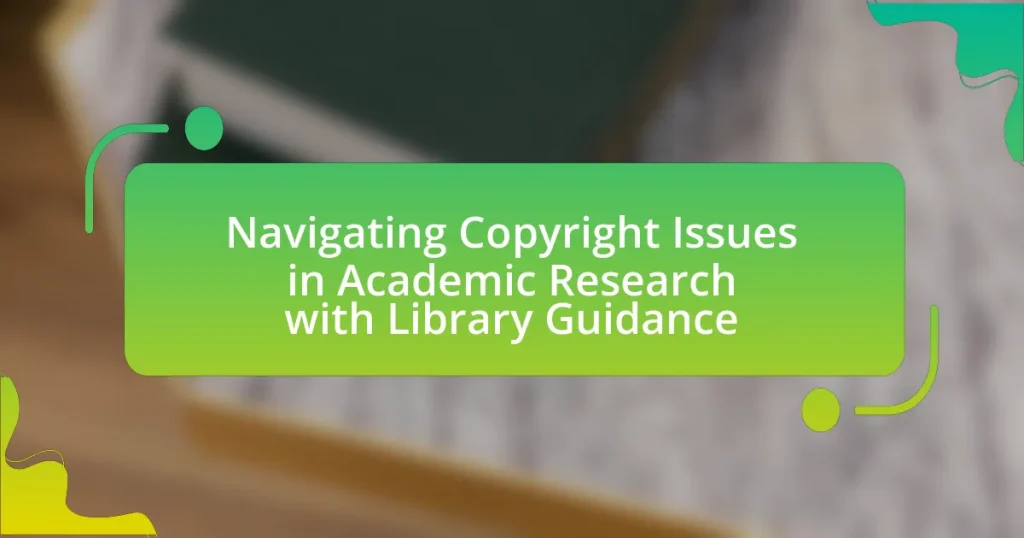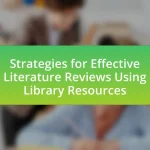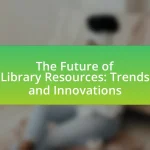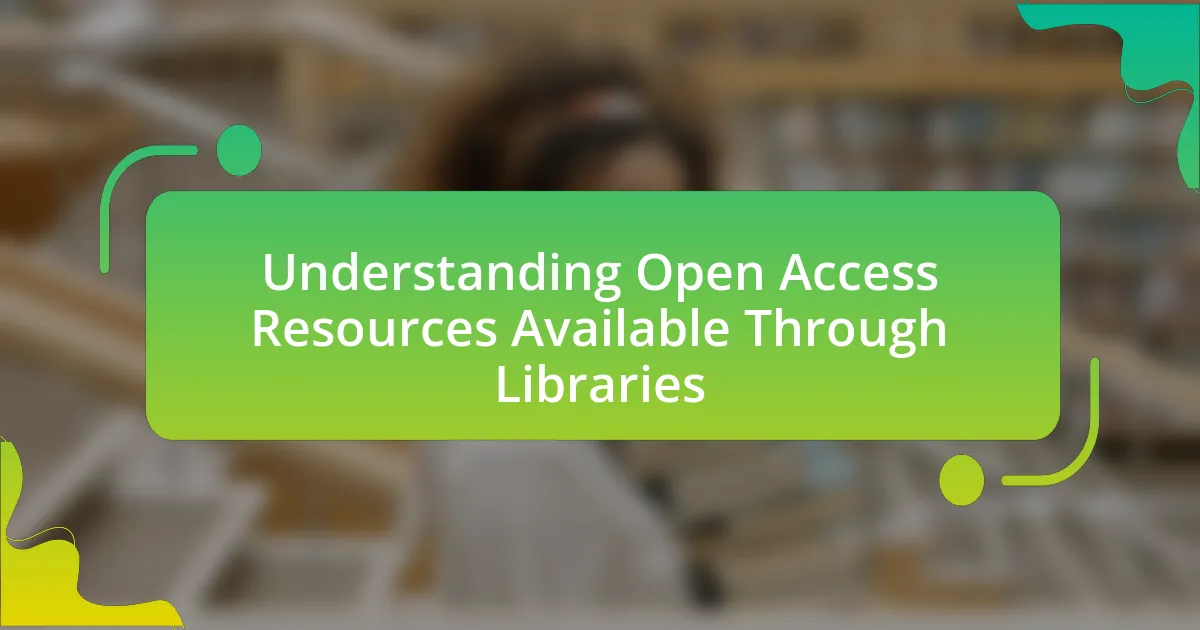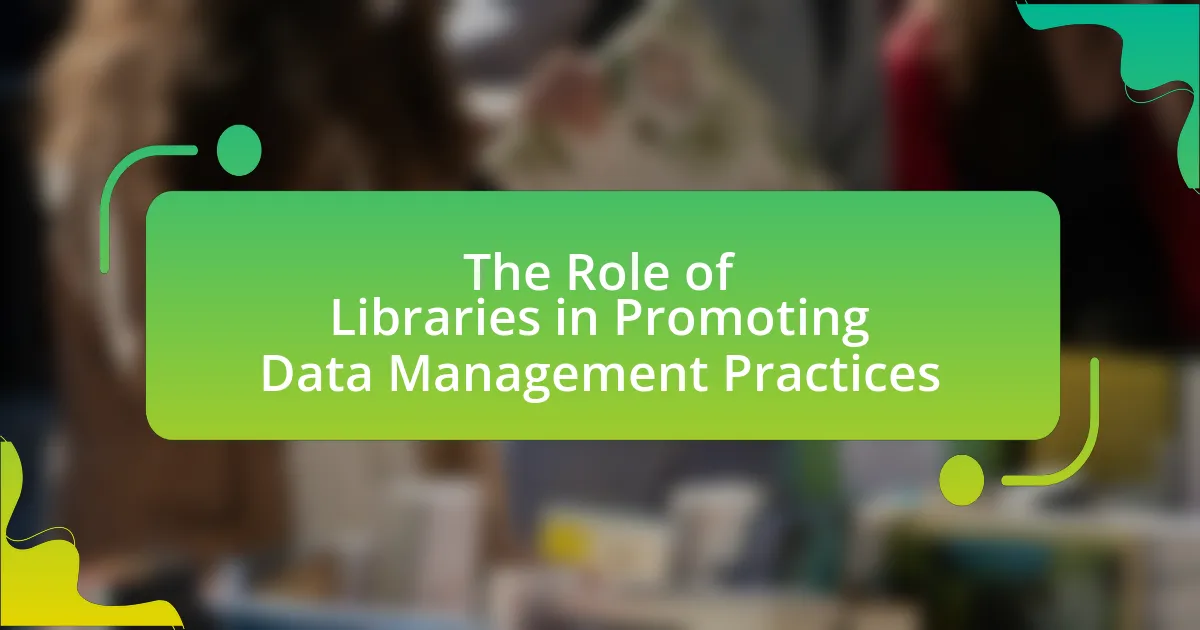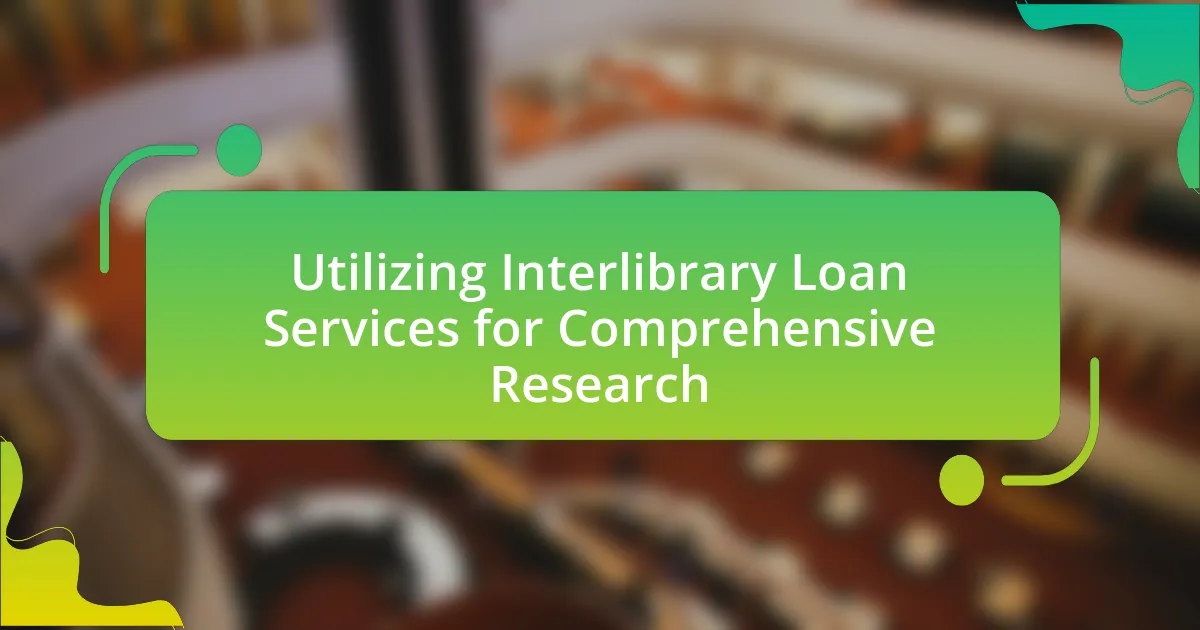The article focuses on navigating copyright issues in academic research, emphasizing the importance of understanding copyright laws, fair use provisions, and the role of libraries in providing guidance. It outlines the complexities researchers face regarding the unauthorized use of copyrighted materials, ownership disputes, and the impact of copyright on the dissemination of research findings. Key principles such as fair use, licensing agreements, and proper attribution are discussed, along with practical tips for avoiding copyright infringement. Additionally, the article highlights resources available through libraries to assist researchers in complying with copyright regulations and effectively managing their use of copyrighted materials.

What are Copyright Issues in Academic Research?
Copyright issues in academic research primarily involve the unauthorized use of copyrighted materials, which can lead to legal repercussions. Researchers must navigate the complexities of copyright law, including fair use provisions, which allow limited use of copyrighted works without permission under specific circumstances, such as criticism, comment, news reporting, teaching, scholarship, or research. Additionally, the ownership of research outputs, such as articles and data, can be contentious, particularly when multiple authors or institutions are involved. According to the U.S. Copyright Office, works created by employees in the course of their employment are typically owned by the employer, which can complicate authorship and rights in collaborative research settings. Understanding these issues is crucial for researchers to avoid infringement and ensure compliance with legal standards.
Why is Copyright Important in Academic Research?
Copyright is important in academic research because it protects the intellectual property rights of authors and creators, ensuring that their original works are not used without permission. This legal framework encourages innovation and the dissemination of knowledge by allowing researchers to build upon existing works while respecting the rights of the original creators. For instance, the U.S. Copyright Act of 1976 grants authors exclusive rights to reproduce, distribute, and display their works, which fosters a fair academic environment where contributions are acknowledged and rewarded.
What are the key principles of copyright law relevant to researchers?
The key principles of copyright law relevant to researchers include the protection of original works, the concept of fair use, and the importance of licensing. Copyright law grants authors exclusive rights to their original works, which means researchers must obtain permission to use copyrighted materials unless an exception applies. Fair use allows limited use of copyrighted material without permission for purposes such as criticism, comment, news reporting, teaching, scholarship, or research, but it is determined on a case-by-case basis considering factors like purpose, nature, amount used, and effect on the market. Additionally, researchers should be aware of licensing agreements that may dictate how they can use and share materials, as many academic publications and databases have specific terms that must be followed. These principles are essential for ensuring compliance with copyright law while conducting research.
How does copyright impact the dissemination of research findings?
Copyright significantly restricts the dissemination of research findings by controlling how and when these findings can be shared and accessed. Researchers must navigate copyright laws to determine if they can publish their work openly or if they need to seek permission from copyright holders, which often includes publishers. For instance, many academic journals require authors to transfer copyright upon publication, limiting the authors’ ability to share their work freely. According to a study published in the journal “PLOS ONE,” approximately 70% of researchers reported facing barriers due to copyright restrictions when attempting to share their findings. This indicates that copyright can hinder the accessibility of research, impacting the overall advancement of knowledge in various fields.
What Common Copyright Challenges Do Researchers Face?
Researchers commonly face challenges such as understanding fair use, obtaining permissions for copyrighted materials, and navigating licensing agreements. Fair use can be ambiguous, leading to uncertainty about what constitutes permissible use of copyrighted works in research. Additionally, researchers often struggle to secure permissions for reproducing images, texts, or data, which can hinder their ability to publish findings. Licensing agreements can also be complex, with varying terms that may restrict access or sharing of research outputs. These challenges are compounded by the rapid evolution of digital content and copyright laws, making it essential for researchers to seek guidance from library resources and copyright experts to navigate these issues effectively.
What are the implications of using copyrighted materials in research?
Using copyrighted materials in research can lead to legal repercussions, including potential lawsuits and financial penalties. Researchers must ensure they have the right to use such materials, as unauthorized use can infringe on the copyright holder’s rights. For instance, the U.S. Copyright Act provides protection to original works, and using these without permission can result in claims of copyright infringement. Additionally, ethical considerations arise, as proper attribution and respect for intellectual property are fundamental to academic integrity. Therefore, researchers should seek permissions, utilize fair use provisions judiciously, and consider licensing options to mitigate risks associated with copyright infringement.
How can researchers avoid copyright infringement?
Researchers can avoid copyright infringement by ensuring they obtain proper permissions for using copyrighted materials. This involves identifying the copyright status of the work, seeking licenses when necessary, and utilizing materials that fall under fair use or public domain. For instance, the U.S. Copyright Office outlines that fair use allows limited use of copyrighted material without permission for purposes such as criticism, comment, news reporting, teaching, scholarship, or research. Additionally, researchers can access resources like Creative Commons, which provide clear licensing options for sharing and using creative works legally.
How Can Libraries Assist with Copyright Issues in Research?
Libraries assist with copyright issues in research by providing access to legal resources, offering copyright education, and facilitating copyright compliance. They often have dedicated staff who can guide researchers on fair use, licensing, and permissions, ensuring that academic work adheres to copyright laws. For instance, many libraries provide workshops or online resources that explain copyright concepts and best practices, which helps researchers understand how to use copyrighted materials legally. Additionally, libraries may have agreements with publishers that allow for broader access to materials, thus supporting research while respecting copyright restrictions.
What resources do libraries provide for understanding copyright?
Libraries provide a variety of resources for understanding copyright, including informational guides, workshops, and access to legal databases. These resources help users navigate copyright laws and policies relevant to academic research. For instance, many libraries offer copyright guides that outline key concepts, such as fair use and licensing, often tailored to specific disciplines. Additionally, libraries frequently conduct workshops that educate researchers on copyright issues, providing practical examples and case studies. Access to legal databases, such as Westlaw or LexisNexis, allows users to explore copyright case law and statutes, further enhancing their understanding. These resources collectively empower researchers to make informed decisions regarding copyright in their academic work.
How can librarians help researchers navigate copyright complexities?
Librarians can help researchers navigate copyright complexities by providing expert guidance on copyright laws, fair use, and licensing agreements. They offer resources such as workshops, one-on-one consultations, and access to legal databases that clarify copyright issues. For instance, librarians can explain the nuances of fair use, which allows limited use of copyrighted material without permission under specific conditions, thus empowering researchers to make informed decisions about their work. Additionally, librarians often curate collections of open-access materials and provide information on Creative Commons licenses, which facilitate the sharing and use of research outputs while respecting copyright.

What Types of Copyrighted Materials Are Commonly Used in Research?
Commonly used types of copyrighted materials in research include scholarly articles, books, images, music, and software. Scholarly articles and books provide foundational knowledge and data, while images and music can enhance presentations and analyses. Software often serves as a tool for data analysis or simulation in various fields. According to the Association of Research Libraries, these materials are essential for advancing knowledge and supporting academic inquiry, highlighting their significance in research contexts.
What are the different categories of copyrighted works?
The different categories of copyrighted works include literary works, musical works, dramatic works, choreographic works, pictorial and graphic works, audiovisual works, sound recordings, and architectural works. Each category is defined by the type of expression it encompasses; for instance, literary works cover books and articles, while musical works include compositions and lyrics. The U.S. Copyright Act of 1976 outlines these categories, establishing the legal framework for the protection of creative expressions in various forms.
How do different types of works affect copyright considerations?
Different types of works significantly influence copyright considerations due to their varying levels of protection and the specific rights granted to creators. For instance, literary works, musical compositions, and visual arts are automatically protected upon creation, granting authors exclusive rights to reproduce, distribute, and display their works. In contrast, facts and ideas are not copyrightable, which means that while the expression of those ideas can be protected, the underlying concepts remain free for public use. Additionally, works created by employees in the course of their employment typically belong to the employer, altering the ownership dynamics compared to independent creators. These distinctions are crucial for academic researchers, as they navigate the complexities of using copyrighted materials in their work, ensuring compliance with copyright laws while maximizing their ability to utilize various types of works effectively.
What is the significance of fair use in academic research?
Fair use is significant in academic research as it allows scholars to utilize copyrighted materials without permission for purposes such as criticism, comment, news reporting, teaching, scholarship, or research. This legal doctrine promotes the advancement of knowledge by enabling researchers to reference and build upon existing works, fostering innovation and academic discourse. For instance, the U.S. Copyright Act of 1976 outlines four factors to determine fair use: the purpose and character of the use, the nature of the copyrighted work, the amount used, and the effect on the market for the original work. These factors provide a framework that supports the use of materials in a way that balances the rights of copyright holders with the public interest in accessing information for educational purposes.
How Can Researchers Properly Attribute Copyrighted Works?
Researchers can properly attribute copyrighted works by clearly citing the original source in accordance with established citation styles, such as APA, MLA, or Chicago. Accurate citation includes the author’s name, publication year, title of the work, and publication details, which ensures that credit is given to the original creator and helps avoid plagiarism. For instance, the APA style requires the author’s last name and the year of publication in-text, along with a full reference in the bibliography. This practice is supported by the U.S. Copyright Office, which emphasizes that proper attribution is essential for respecting the rights of copyright holders and maintaining academic integrity.
What citation styles are recommended for acknowledging sources?
The recommended citation styles for acknowledging sources include APA (American Psychological Association), MLA (Modern Language Association), and Chicago style. These styles are widely used in academic writing to ensure proper attribution of ideas and research. APA is commonly utilized in the social sciences, MLA is favored in the humanities, and Chicago style is often used in history and some other disciplines. Each style has specific guidelines for formatting citations and references, which helps maintain academic integrity and avoid plagiarism.
How does proper attribution help in avoiding copyright issues?
Proper attribution helps in avoiding copyright issues by clearly acknowledging the original creator of a work, which demonstrates respect for intellectual property rights. When researchers provide proper attribution, they indicate that they are using someone else’s ideas or materials, thereby reducing the risk of plagiarism and copyright infringement. According to the U.S. Copyright Office, proper attribution can serve as a defense against claims of copyright violation, as it shows that the user intended to give credit and did not claim the work as their own. This practice not only fosters academic integrity but also aligns with legal standards that protect creators’ rights.

What Are the Best Practices for Navigating Copyright in Academic Research?
The best practices for navigating copyright in academic research include understanding copyright laws, utilizing fair use provisions, and seeking permission for copyrighted materials. Researchers should familiarize themselves with the specific copyright regulations applicable to their field, as these can vary significantly. Fair use allows limited use of copyrighted material without permission under certain conditions, such as for criticism, comment, or educational purposes, but it is essential to evaluate each case individually. Additionally, obtaining permission from copyright holders for any substantial use of their work is crucial to avoid infringement. Academic institutions often provide resources and guidance through their libraries, which can assist researchers in understanding these practices and ensuring compliance with copyright laws.
How can researchers ensure compliance with copyright laws?
Researchers can ensure compliance with copyright laws by obtaining permission for the use of copyrighted materials and adhering to fair use guidelines. This involves identifying the copyright status of the materials they wish to use, seeking licenses when necessary, and understanding the limitations of fair use, which allows limited use of copyrighted works without permission under specific circumstances, such as for criticism, comment, news reporting, teaching, scholarship, or research. Additionally, researchers should consult their institution’s library resources and copyright offices, which provide guidance on copyright issues and access to copyright law resources, ensuring that their research practices align with legal requirements.
What steps should researchers take before using copyrighted materials?
Researchers should first determine whether the materials they intend to use are protected by copyright. This involves checking the copyright status of the materials, which can typically be found through databases or copyright registries. Next, researchers should evaluate the purpose of their use to see if it qualifies as fair use under copyright law, considering factors such as the purpose, nature, amount, and effect of the use on the market value of the original work. If fair use does not apply, researchers must seek permission from the copyright holder, which may involve contacting publishers or authors directly. Additionally, researchers should explore licensing options or consider using materials that are in the public domain or available under open access licenses. These steps ensure compliance with copyright laws and protect researchers from potential legal issues.
How can researchers effectively communicate with copyright holders?
Researchers can effectively communicate with copyright holders by clearly articulating their intentions and the specific use of copyrighted material. This involves providing detailed information about the project, including the purpose, scope, and how the material will be used, which helps copyright holders understand the context and potential impact of the request. Additionally, researchers should utilize formal channels of communication, such as written requests or official forms, to ensure professionalism and clarity. According to the Copyright Clearance Center, clear communication increases the likelihood of obtaining permissions and fosters positive relationships with copyright holders.
What Resources Are Available for Further Guidance on Copyright?
Resources available for further guidance on copyright include the U.S. Copyright Office, which provides comprehensive information on copyright laws and regulations. The U.S. Copyright Office offers online resources, including FAQs, guides, and educational materials that clarify copyright issues relevant to academic research. Additionally, many academic libraries provide copyright support services, including workshops, consultations, and access to copyright management tools. These resources are designed to assist researchers in understanding their rights and responsibilities regarding copyright in their work.
What online tools and databases can assist with copyright inquiries?
Online tools and databases that assist with copyright inquiries include the U.S. Copyright Office’s website, which provides comprehensive information on copyright registration and laws. Additionally, the Creative Commons platform offers resources for understanding copyright licenses and sharing creative works legally. The Copyright Clearance Center is another valuable resource, providing licensing services and information on copyright permissions. These platforms are widely recognized and utilized by researchers and academics to navigate copyright issues effectively.
How can researchers stay updated on copyright law changes?
Researchers can stay updated on copyright law changes by subscribing to legal newsletters, following relevant organizations, and attending workshops or webinars focused on copyright issues. Legal newsletters, such as those from the American Bar Association, provide timely updates on legislative changes and case law. Organizations like the Copyright Alliance and the Association of Research Libraries often share insights and resources on their websites and through social media. Additionally, many universities offer workshops or online courses that cover copyright law, helping researchers understand the implications of changes in the law.
What Practical Tips Can Help Researchers Avoid Copyright Issues?
Researchers can avoid copyright issues by adhering to several practical tips. First, they should familiarize themselves with copyright laws and fair use guidelines, which allow limited use of copyrighted material without permission under specific circumstances. Second, obtaining permission from copyright holders for any material that exceeds fair use is essential. Third, utilizing resources from libraries, such as licensed databases and open-access journals, can provide access to materials without copyright infringement. Additionally, researchers should always properly attribute sources and maintain clear records of permissions obtained. These practices help ensure compliance with copyright regulations and protect researchers from potential legal disputes.
